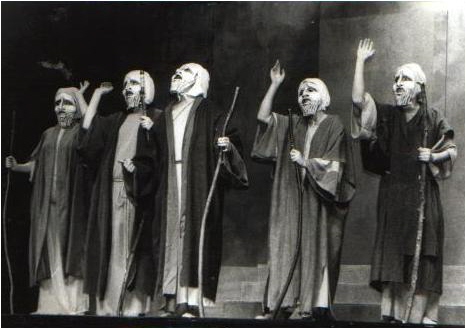Theater, and by extension the mask, plays an integral role in the mediation of social issues within this particular society.
Simon Goldhill has discussed the possibility that tragedy is one way that the Athenians formed and mediated the discussion of the conflict between legal justice and the “justice of the gods”. The debate as to whether the gods were always right was an ongoing issue in Ancient Greece and it shows through in their art. This was a particularly important question in this newly developed polis that had only created their radical democracy in 407BC. Thus the stage served as a place for the matter to be discussed “es meson”, which, according to Goldhill, means “in the middle” or “to be put in the public domain to be contested” (pg. 16). Goldhill links this mediated discussion to the presence of the chorus in Greek Theater, which can be extrapolated to the physicality of their masks.
Goldhill calls the chorus’ characterization a “duality of role”. He says that they are both a commenter on the play and a character within it and that the chorus “mirrors, mediates, and otherwise directs the collective response of the audience”. He calls the chorus a “collective sounding-board, as it were, for the collective of the polis” (pg18). Within these plays the chorus does play a sort of interceding role. They will often comment on what has just happened on stage, or prepare the audience for what might be coming next. If there are two major conflicting views onstage they are often trying to arbitrate the discussion to avoid rash action, which, in Greek Tragedy, never works. For example, the chorus tries to talk sense into Ajax before he kills himself, but it is a hopeless case. The only real exceptions to this are when the chorus is the main character, as in The Suppliants, or when they portray a group of people with one of the extreme views, as in The Eumenides when the chorus plays the Furies calling for the gods’ justice to Orestes.
Once again, the mask plays a role in the arbitrative nature of the chorus. Tragic masks are not majorly caricaturized like comedic masks (see Comedy and Tragedy). Instead, they “tended to present a somewhat blank expression, enlivened only by the gaping mouth through which the actor’s voice had to be projected” (Mack 1994). They were “carefully painted figural representations” (pg. 17), however, “portrayal of individual personality was eschewed in favor of an ideal form” (Mack 1994). Tragic masks, therefore, were very neutral things, with their characterization depending totally on the actor’s personality to enliven it. They would be slightly differentiated to give the difference between, for example, Antigone and Creon. The chorus, meanwhile, though differentiated from the three main actors, would be in all the same mask. They would be a sea of the same neutral faces. In addition, within the scope of the physical layout of the theater, the chorus would be situated in the orchestra, which was situated between the raised stage on which the actors performed and the area where the audience sat. Thus, the chorus and their masks, were physically “es meson” of the actors and audience.

